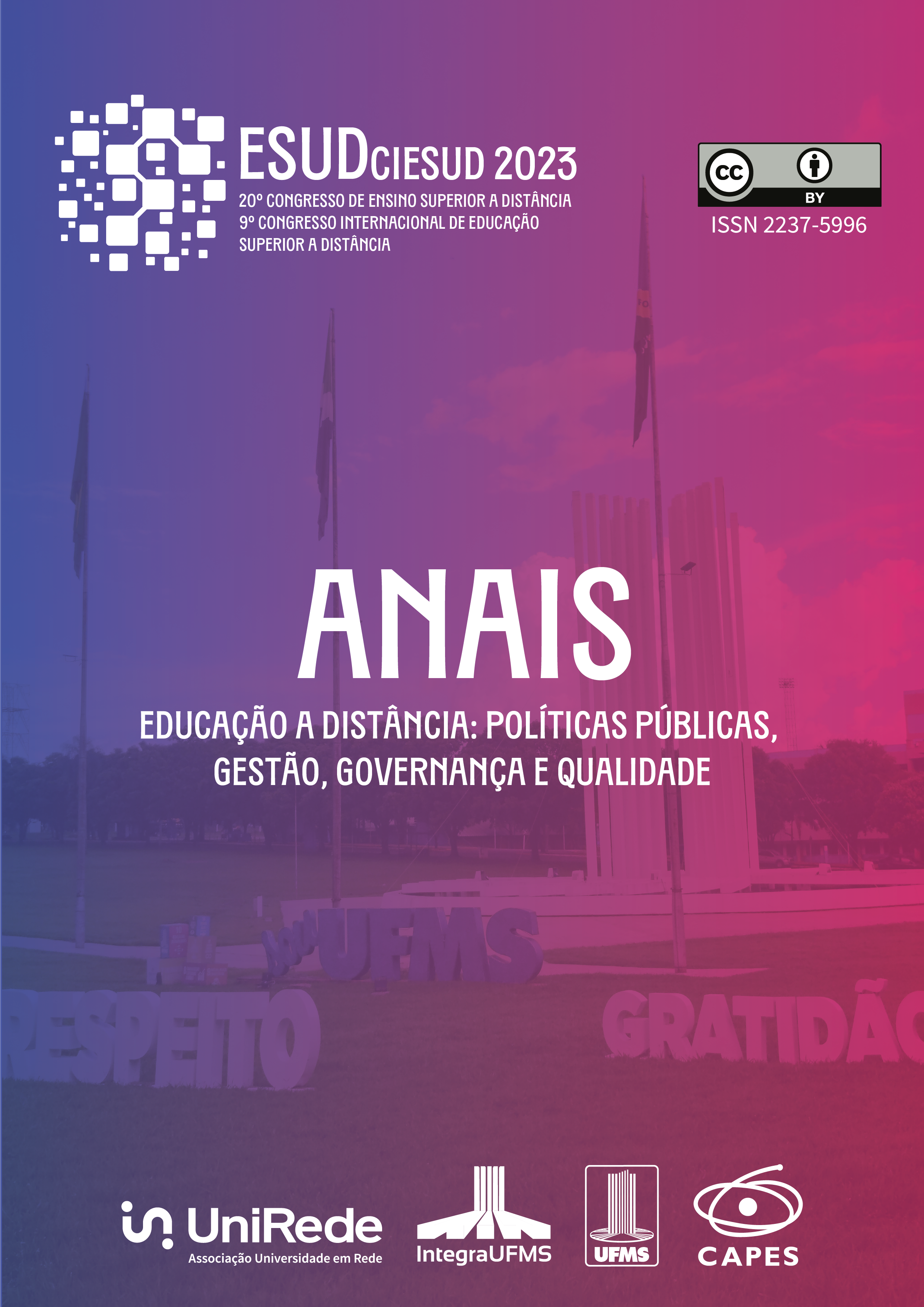DIGITAL TECHNOLOGIES IN EDUCATION
THE HIGHLIGHTED APPROACH OF DISTRIBUTED COGNITION
Keywords:
Distributed cognition, Digital Technologies, EducationAbstract
This article aims to discuss digital technologies in education from the perspective of distributed cognition (HUTCHINS, 2000; SALOMON, 2001). The theory of distributed cognition conceives cognition as a phenomenon that goes beyond the individual, being influenced by human social nature, as well as by the historical-cultural and material context produced by humanity. Thus, this approach is based on two essential principles. First, it considers cognition as a process that can occur in any context. Second, it goes beyond biological aspects by acknowledging that cognitive processes are influenced by the material world, offering opportunities to reorganize the cognitive system through both internal and external interactions. In a radical way, distributed cognition assumes that cognitive processes are inseparable from the interaction between the subject and the world, as well as from the technical artifacts present in this context. Understanding cognition as the result of complex and interconnected networks, in which human, biological, and technological factors interact, allows for a (re)evaluation of educational processes. From this perspective, we point out that schools should consider the current sociocultural context in their practices, aiming to ensure that students have autonomy and competence to participate, act, and learn critically in this new reality.
References
ALMEIDA, D. Validade Ecológica de um Simulador de Voo para PC no uso de inglês como L2. 2011. Tese (Doutorado em Linguística Aplicada) – Faculdade de Letras, Universidade Federal de Minas Gerais, Belo Horizonte, 2011.
ALMEIDA, D. C.; SOUZA, R. A. Mediação tecnológica e experiências linguísticas emergentes: Uma proposta de leitura a partir da teoria da Cognição Distribuída. Revista Contextos Linguísticos. v. 5, n. 5, mar. 2011. Disponível em: https://link.ufms.br/BhxQT Acesso em: 10 jun. 2023.
ASSMANN, H. A metamorfose do aprender na sociedade da informação. Ciência Da Informação, Brasília, v. 29, n. 2, maio./ago. 2000. Disponível em: https://link.ufms.br/VImOh. Acesso em: 22 jun. 2023.
BRUNO, F. Tecnologias cognitivas e espaços do pensamento. In: FRANÇA, V.; WEBER, M. H.; PAIVA, R; SOVIK, L. (org.). Livro da XI Compós 2002: Estudos de Comunicação. Porto Alegre: Sulina, 2003. p. 193-217.
DEMO, P. Ambivalências da sociedade da informação. Ciência da Informação, Brasília, v. 29, n. 2, maio./ago. 2000. Disponível em: https://link.ufms.br/kGMQe . Acesso em: 05 maio. 2023.
HOLLAN J.; HUTCHINS, E.; KIRSH, D. Distributed Cognition: Toward a New Foundation for Human-Computer Interaction Research. ACM Transactions on Computer-Human Interaction, v. 7, n. 2, 2000. Disponível em: https://link.ufms.br/QywQh. Acesso em: 10 jan. 2016.
HUTCHINS, E. Distributed Cognition, 2000. Disponível em: https://link.ufms.br/07z6W . Acesso em: 10 mai. 2023.
LAKATOS, E. M.; MARCONI, M. A. Fundamentos de Metodologia Científica. São Paulo, SP: Atlas 2003.
LUCAS, M.; MOREIRA, A. A Web Social: complemento informal às aprendizagens formais. In: DIAS, P.; OSÓRIO, A. (org.). Actas do VI Conferência Internacional de TIC na Educação. Braga: Universidade do Minho, 2009. p. 121-134. Disponível em: https://link.ufms.br/xZ0Lc Acesso em: 02 maio. 2023.
MATLIN, M. Psicologia cognitiva 5ª ed. Rio de Janeiro, RJ: LTC, 2004.
MOREIRA, A. F.; BORGES, O. Ambiente de aprendizagem em Física mediado por animações. Revista Brasileira de Pesquisa em Educação em Ciências, v. 7, n. 1, 2007. Disponível em: https://link.ufms.br/WpqNH. Acesso em: 01 jun. 2023.
MOTA, J. C. Da Web 2.0 ao e-Learning 2.0: Aprender na Rede.. Dissertação (Mestrado em Ciências da Educação) – Universidade Aberta, 2009.
PEREIRA, A.; OSTERMANN, F.; CAVALCANTI, C. J. H. Um exemplo de "distribuição social da mente" em uma aula de física quântica. Ciênc. Educ (Bauru), Bauru, v. 18, n. 2, 2012. Disponível em: https://link.ufms.br/gLiAW. Acesso em: 16 maio. 2023.
PERKINS, D. N. Person-plus: a distributed view of thinking and learning. In: SALOMON, G. (Ed.) Distributed Cognitions: Psychological and educational considerations. Cambridge: Cambridge University Press, 2001. p. 88-109.
ROGERS, Y. A Brief Introduction to Distributed Cognition, 1997. Disponível: https://link.ufms.br/CDDSZ. Acesso em: 10 maio. 2023.
SALOMON, G. No distribution without individuals cognition: a dynamic interactional view. In: SALOMON, G. (org. .). Distributed Cognitions: Psychological and educational considerations. Cambridge: Cambridge University Press, 2001. p. 111-137.
Downloads
Published
How to Cite
Issue
Section
License
Copyright (c) 2024 Analígia Miranda da Silva

This work is licensed under a Creative Commons Attribution 4.0 International License.
The event uses the Creative Commons License - Attribution 4.0 International as a basis. It believes in the importance of the open access movement in scientific journals, such as the Open Archives Initiative.
By submitting a text to the event, the authors agree to the following terms:
- The authors agree to license works accepted for publication under the Creative Commons License - Attribution 4.0 International.
- With CC-BY 4.0 licensing, authors maintain intellectual rights over the text and grant the event the right to first publication.
- The authors authorize the sending and indexing of texts written by them in databases and academic and scientific information portals.
- Authors are allowed and encouraged to publish and distribute their work online, in institutional repositories, on personal pages and academic social networks, after the editorial process, as long as the forms of licensing and presentation of the text are respected, in addition to the indication of the place of origin of the publication, in this case, the link to the event publishing system.
- The authors of the works published in the event are expressly responsible for their content.
- All works submitted to the event that have images, photographs, figures in which images of human beings are registered in their bodies must be accompanied by an Image Use Authorization Term by the member participating in the image and, in the case of children, family members of exposed children, with data and signature.





